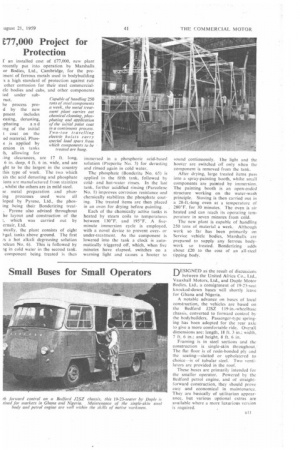E77,000 Project for Protection
Page 45

If you've noticed an error in this article please click here to report it so we can fix it.
1an installed cost of £77,000, new plant recently put into operation by Marshal's
or Bodies, Ltd., Cambridge, for the pre
:ment of ferrous metals used in bodybuilding .s a high standard of protection against rust
other corrosion for their steel commercialcle bodies and cabs, and other components ted under subract.
he process pro d by the new pment includes easing, derusting, ;phating and ing of the initial t coat on the ed material. Phos e Is applied by ersion in tanks It, allowing for .ing clearances, are 17 ft. long, 6 in. deep, 4 ft. 6 in. wide, and are ght to be the largest in the country this type of work. The two which tin the acid derusting and phosphate ions are manufactured from stainless , whilst the others are in mild steel. te . metal preparation and phosing processes used were all loped by Pyrene, Ltd., the phosing being their Bonderizing treat.. Pyrene also advised throughout he layout and construction of the which was carried out by ernair, Ltd.
sically, the plant consists of eight 1-gal, tanks above ground. The first rs a hot alkali degreasing solution )clean No. 6). This is followed by ig in cold water in the second tank. component being treated is then
Capable of handling 250 tons of steel components a week, the metal treatment plant carries out chemical cleaning, phosphating and application of the initial paint coat in a continuous process. Two-ton travelling electric hoists carry special load spars from which components to he •
treated are hung, immersed in a phosphoric acid-based solution (Preperite No. 3) for derusting and rinsed again in cold water.
The phosphate (Bonderite No. 65) is applied in the fifth tank, followed by coldand hot-water rinses. In the last tank, further acidified rinsing (Parcolene No. 1) improves corrosion resistance and chemically stabilizes the phosphate coating. The treated items are then placed in an oven for drying before painting.
Each of the chemically active tanks is heated by steam coils to temperatures between 130°F. and 195°F. A fiveminute immersion cycle is employed. with a novel device to prevent overor under-treatment. As the component is lowered into the tank a clock is automatically triggered off, which, when five minutes have elapsed, switches on a warning light and causes a hooter to sound continuously. The light and the hooter are switched off only when the component is removed from the tank.
After drying, large treated items pass into a spray-painting booth, whilst small components are painted by immersion. The painting booth is an open-ended structure working on the water-wash principle. Stoving is then carried out in a 28-ft.-Iong oven at a temperature of 280°F. for 30 minutes. The oven is air heated and can reach its operating temperature in seven minutes from cold.
The new plant is capable of handling 250 tons of material a week. Although work so far has been primarily on Service vehicle bodies. Marshal's are prepared to supply any ferrous bodywork so treated. Boriderizing adds about £20 to the cost of an all-steel tipping body.




































































































